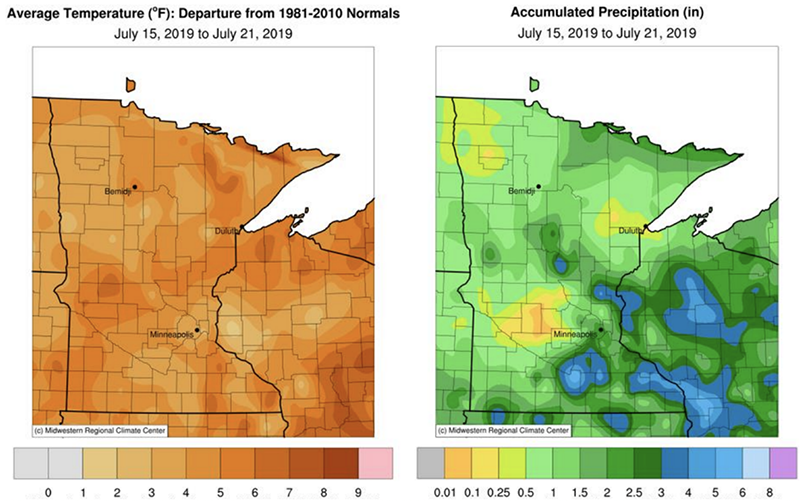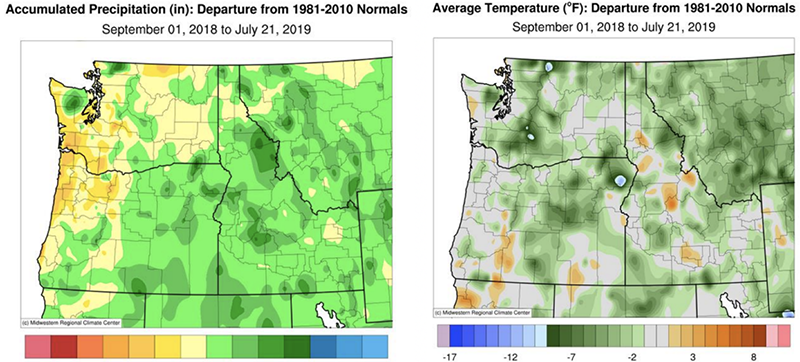July 24, 2019
For the week ending July 21st, pulse crops were blooming across the major growing areas.

Across the major pulse growing areas of the U.S., dry bean, pea, lentil and chickpea crops entered the blooming stage, and in some areas were setting pods. In the Pacific Northwest, the dry pea crop is being harvested.
Michigan
Michigan is an important black bean growing state. Last week, 5.6 days were suitable for fieldwork. Early in the season, wet conditions delayed planting, but the dry bean crop is finally in the ground, with 84% emerged (behind the average of 99%) and 4% blooming (behind the average of 22%). The crop rated 16% very poor to poor, 27% fair, 42% good and 15% excellent.
Minnesota
Minnesota is a key kidney bean growing state. Last week, high winds, hail and torrential rains left farmers with 3.8 days suitable for fieldwork. Top- and subsoil moisture levels rated 97% and 95% adequate to surplus, respectively. The dry bean crop was blooming (47%) and setting pods (11%), and rated 69% good to excellent.

Montana
Montana is a major producer of pulse crops. Last week saw scattered showers across the state. Top- and subsoil moisture levels rated 81% and 74% adequate to surplus, respectively. The dry bean (including chickpeas), dry pea and lentil crops were blooming at 45, 97 and 88% respectively. The dry pea crop rated 7% very poor to poor, 27% fair, 55% good and 11% excellent. The lentil crop rated 4% poor, 39% fair, 46% good and 11% excellent.
North Dakota
North Dakota is the country’s top dry bean producing state. Last week, 5.4 days were suitable for fieldwork. Top- and subsoil moisture levels rated 84% and 82% adequate to surplus, respectively. The dry pea crop rated 4% poor, 19% fair, 70% good and 7% excellent. 91% of the pea plants were blooming and 13% were dropping leaves. The dry bean crop rated 2% poor, 22% fair, 64% good and 12% excellent. Blooming was at 68%, ahead of the average pace of 63%, with 14% of the plants setting pods.
Pacific Northwest
The Pacific Northwest is an important pulse producing region. Lately, the region has received favorable weather. Last week, there were 6.9 days suitable for fieldwork in Idaho, 6.8 in Oregon and 7 in Washington. The dry bean crop in Idaho rated 37% fair, 58% good and 5% excellent. In Oregon, it rated 7% very poor to poor, 28% fair, 54% good and 11% excellent. In Washington, the bean crop rated 7% poor, 29% fair, 57% good and 7% excellent. The dry pea crop in Idaho rated 36% fair, 56% good and 8% excellent. In Oregon, it rated 19% very poor to poor, 20% fair, 37% good and 24% excellent. In Washington, it rated 1% poor, 11% fair, 82% good and 6% excellent. The dry pea harvest is underway, with harvest progress at 2% in Idaho, 24% in Oregon and 14% in Washington.

Disclaimer: The opinions or views expressed in this publication are those of the authors or quoted persons. They do not purport to reflect the opinions or views of the Global Pulse Confederation or its members.